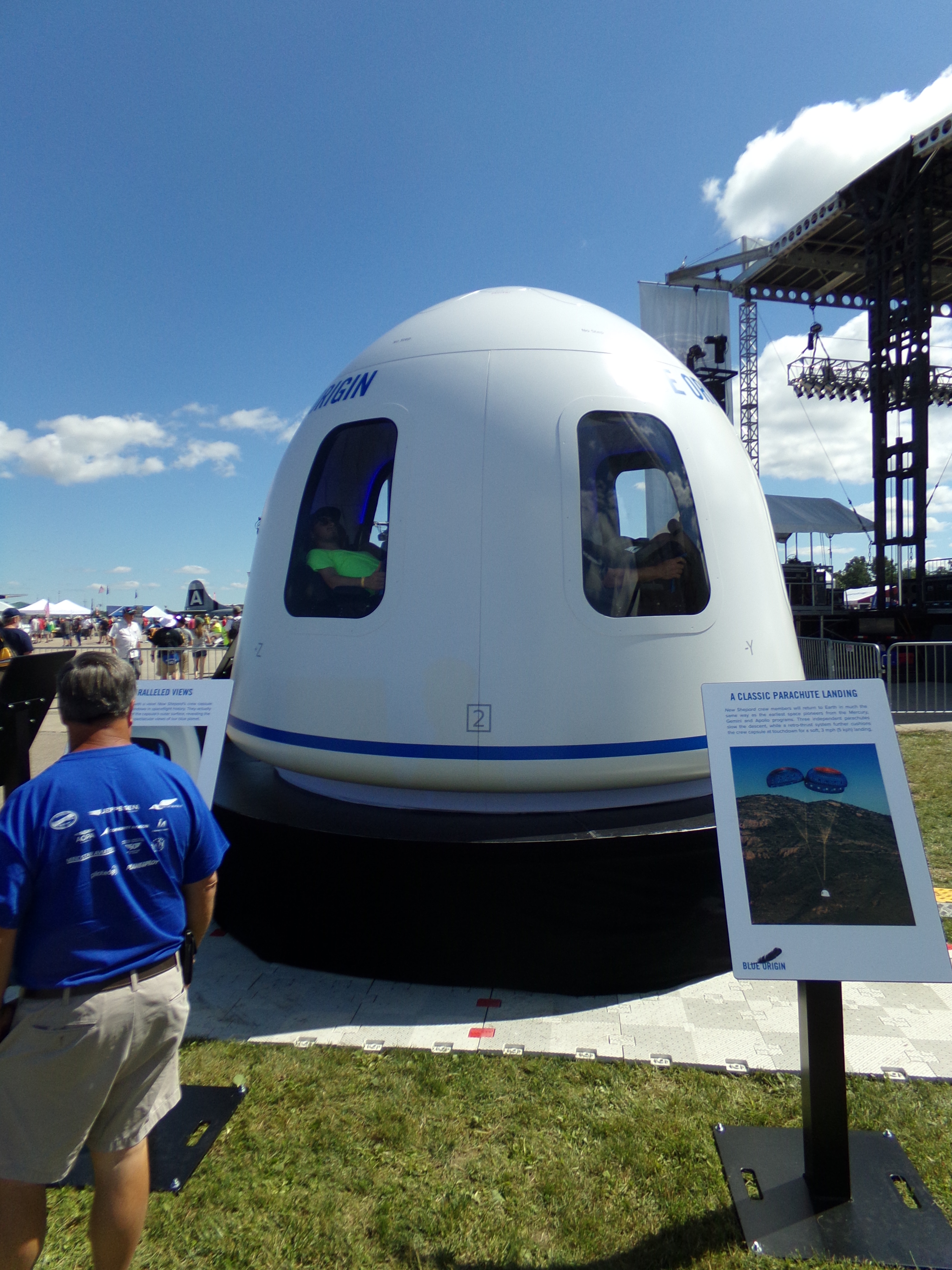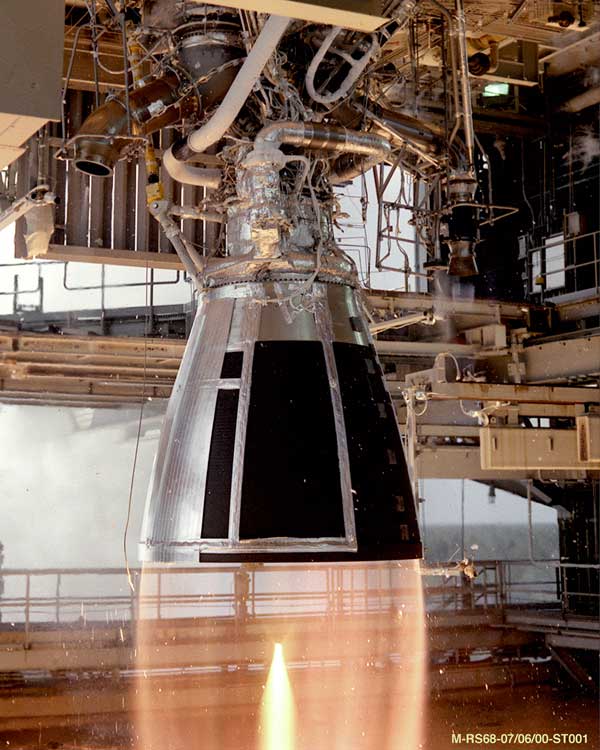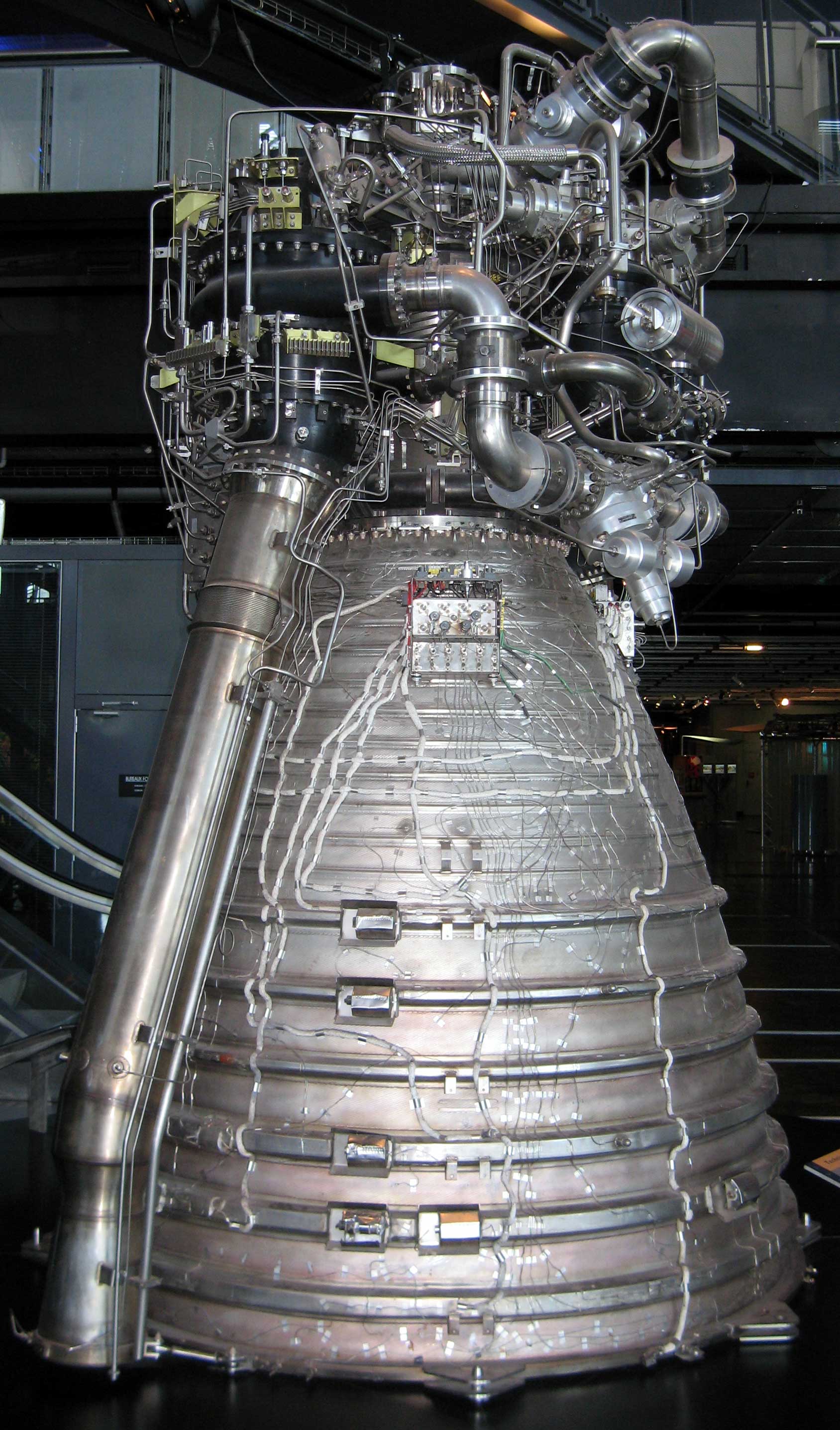|
BE-3
The BE-3 (Blue Engine 3) is a liquid hydrogen/liquid oxygen rocket engine developed by Blue Origin. The engine began development in the early 2010s and completed acceptance testing in early 2015. The engine is being used on the New Shepard suborbital rocket, for which made its first test flight on 29 April 2015 and had its first crewed flight on 20 July 2021. A variant of the engine is being used in the 2nd stage of the New Glenn orbital rocket, for which made its inaugural flight on 16 January 2025. In 2015, the engine was under consideration by United Launch Alliance (ULA) for use in a new second stage, the Advanced Cryogenic Evolved Stage, in ULA's Vulcan orbital launch vehicle with first flight in the 2020s. History Following Aerojet’s acquisition of Pratt & Whitney Rocketdyne in 2012, Blue Origin president Rob Meyerson saw an opportunity to fill a gap in the defense industrial base. Blue Origin publicly entered the liquid rocket engine business by partnering with ULA ... [...More Info...] [...Related Items...] OR: [Wikipedia] [Google] [Baidu] |
Blue Origin
Blue Origin Enterprises, L.P. is an American space technology company headquartered in Kent, Washington. The company operates the suborbital New Shepard rocket and the heavy-lift New Glenn rocket. In addition to producing engines for its own rockets, Blue Origin supplies engines for other vehicles, including United Launch Alliance's Vulcan Centaur. It is also working on the Blue Moon (spacecraft), Blue Moon human lunar lander for NASA's Artemis program, the Blue Ring spacecraft platform, and the Orbital Reef space station in partnership with other organizations. Founded in 2000 by Jeff Bezos, Blue Origin initially operated with a stealth startup, very low profile, funded by Bezos's private investments. In 2015, the company achieved a significant milestone with the first uncrewed launch and landing of the New Shepard and announced plans for New Glenn. In 2021, New Shepard completed its first crewed mission with Bezos himself on board, crossing the Kármán line, the conventiona ... [...More Info...] [...Related Items...] OR: [Wikipedia] [Google] [Baidu] |
New Glenn
New Glenn is a heavy-lift launch vehicle developed and operated by the American company Blue Origin. The rocket is designed to have a Reusable launch vehicle, partially reusable, two-stage design with a diameter of . The first stage is powered by seven BE-4 engines, while the second stage relies on two BE-3, BE-3U engines, all designed and built in-house by Blue Origin. It launches from Cape Canaveral Launch Complex 36, with future missions planned from Vandenberg Space Launch Complex 9. Development of New Glenn began prior to 2013 and was officially announced in 2016. The rocket is named in honor of NASA astronaut John Glenn, the first American to orbit Earth. The inaugural vehicle was unveiled on the launch pad in February 2024. Its maiden flight took place on 16 January 2025, carrying a prototype Blue Ring spacecraft, marking the first launch from LC-36 since NROL-23 in 2005. This mission served as the first of several demonstration launches required to be certified for use b ... [...More Info...] [...Related Items...] OR: [Wikipedia] [Google] [Baidu] |
Blue Origin New Shepard
New Shepard is a fully reusable sub-orbital launch vehicle developed for space tourism by Blue Origin. The vehicle is named after Alan Shepard, who became the first American to travel into space and the fifth person to walk on the Moon. The vehicle is capable of vertical takeoff and landings. Additionally, it is also capable of carrying humans and customer payloads into a sub-orbital trajectory. New Shepard consists of a launch rocket and a crew capsule. The capsule can be configured to house up to six passengers, cargo, or a combination of both. The launch rocket is powered by one BE-3PM engine, which sends the capsule above the Kármán line, where passengers and cargo can experience a few minutes of weightlessness before the capsule returns to Earth. The launch vehicle is designed to be fully reusable, with the capsule returning to Earth via three parachutes and a solid rocket motor. The rocket lands vertically on a landing pad 3.2km north of the launch pad. The compa ... [...More Info...] [...Related Items...] OR: [Wikipedia] [Google] [Baidu] |
New Shepard
New Shepard is a Reusable launch vehicle, fully reusable Sub-orbital spaceflight, sub-orbital launch vehicle developed for space tourism by Blue Origin. The vehicle is named after Alan Shepard, who became the List of space travelers by nationality, first American to travel into space and the Apollo 14, fifth person to walk on the Moon. The vehicle is capable of VTVL, vertical takeoff and landings. Additionally, it is also capable of carrying humans and customer payloads into a Sub-orbital spaceflight, sub-orbital trajectory. New Shepard consists of a Launch vehicle, launch rocket and a crew capsule. The capsule can be configured to house up to six passengers, cargo, or a combination of both. The launch rocket is powered by one BE-3, BE-3PM engine, which sends the capsule above the Kármán line, where passengers and cargo can experience a few minutes of weightlessness before the capsule returns to Earth. The launch vehicle is designed to be fully reusable, with the capsule ret ... [...More Info...] [...Related Items...] OR: [Wikipedia] [Google] [Baidu] |
Combustion Tap-off Cycle
The combustion tap-off cycle is a power cycle of a bipropellant rocket engine. The cycle takes a small portion of hot exhaust gas from the rocket engine's combustion chamber and routes it through turbopump turbines to pump fuel before being exhausted (similar to the gas-generator cycle). Since fuel is exhausted, the tap-off cycle is considered an open-cycle engine. The cycle is comparable to a gas-generator cycle engine with turbines driven by main combustion chamber exhaust rather than a separate gas generator or preburner. The J-2S rocket engine, a cancelled engine developed by NASA, used the combustion tap-off cycle and was first successfully tested in 1969. By 2013, Blue Origin, with their New Shepard launch vehicle, had successfully flight-tested the BE-3 engine using a tap-off cycle. According to Blue Origin, the cycle is particularly suited to human spaceflight due to its simplicity, with only one combustion chamber and a less stressful engine shutdown process. However, ... [...More Info...] [...Related Items...] OR: [Wikipedia] [Google] [Baidu] |
Rocket Engine
A rocket engine is a reaction engine, producing thrust in accordance with Newton's third law by ejecting reaction mass rearward, usually a high-speed Jet (fluid), jet of high-temperature gas produced by the combustion of rocket propellants stored inside the rocket. However, non-combusting forms such as cold gas thrusters and nuclear thermal rockets also exist. Rocket vehicles carry their own oxidiser, unlike most combustion engines, so rocket engines can be used in a vacuum, and they can achieve great speed, beyond escape velocity. Vehicles commonly propelled by rocket engines include missiles, Rocket-assisted projectile, artillery shells, ballistic missiles and rockets of any size, from tiny Rocket (firework), fireworks to Rocket (weapon), man-sized weapons to huge Space vehicle, spaceships. Compared to other types of jet engine, rocket engines are the lightest and have the highest thrust, but are the least propellant-efficient (they have the lowest specific impulse). The ideal ... [...More Info...] [...Related Items...] OR: [Wikipedia] [Google] [Baidu] |
Rocket Engine Throttling
A rocket engine is a reaction engine, producing thrust in accordance with Newton's third law by ejecting reaction mass rearward, usually a high-speed jet of high-temperature gas produced by the combustion of rocket propellants stored inside the rocket. However, non-combusting forms such as cold gas thrusters and nuclear thermal rockets also exist. Rocket vehicles carry their own oxidiser, unlike most combustion engines, so rocket engines can be used in a vacuum, and they can achieve great speed, beyond escape velocity. Vehicles commonly propelled by rocket engines include missiles, artillery shells, ballistic missiles and rockets of any size, from tiny fireworks to man-sized weapons to huge spaceships. Compared to other types of jet engine, rocket engines are the lightest and have the highest thrust, but are the least propellant-efficient (they have the lowest specific impulse). The ideal exhaust is hydrogen, the lightest of all elements, but chemical rockets produce a mix ... [...More Info...] [...Related Items...] OR: [Wikipedia] [Google] [Baidu] |
Rocket Engine Restart
A rocket engine is a reaction engine, producing thrust in accordance with Newton's third law by ejecting reaction mass rearward, usually a high-speed jet of high-temperature gas produced by the combustion of rocket propellants stored inside the rocket. However, non-combusting forms such as cold gas thrusters and nuclear thermal rockets also exist. Rocket vehicles carry their own oxidiser, unlike most combustion engines, so rocket engines can be used in a vacuum, and they can achieve great speed, beyond escape velocity. Vehicles commonly propelled by rocket engines include missiles, artillery shells, ballistic missiles and rockets of any size, from tiny fireworks to man-sized weapons to huge spaceships. Compared to other types of jet engine, rocket engines are the lightest and have the highest thrust, but are the least propellant-efficient (they have the lowest specific impulse). The ideal exhaust is hydrogen, the lightest of all elements, but chemical rockets produce a mix of ... [...More Info...] [...Related Items...] OR: [Wikipedia] [Google] [Baidu] |
Rob Meyerson
Robert E. "Rob" Meyerson is an American aerospace engineer and executive. Meyerson is the co-founder and CEO of Interlune, a natural resources company focused on harvesting resources from the Moon. Interlune came out of stealth mode in March 2024. He is the former president of Blue Origin. Career Delalune Space Meyerson is the founder and CEO of Delalune Space, a management consulting firm providing advisory services to the aerospace, mobility, technology, and financial sectors. He is a board director or advisor to numerous organizations. Axiom Space In 2021, it was announced that Meyerson, former Blue Origin president, would be joining Axiom's board of directors and that Axiom Space had raised $130m in a new round of funding. Meyerson stated that Axiom Space is a force in the space sector, and it would enhance the vision for a secure global future. Blue Origin Meyerson joined Blue Origin in 2003 as program manager later becoming the first company president. Work ... [...More Info...] [...Related Items...] OR: [Wikipedia] [Google] [Baidu] |
Cryogenic Rocket Engine
A cryogenic rocket engine is a rocket engine that uses a cryogenic fuel and oxidizer; that is, both its fuel and oxidizer are gases which have been liquefied and are stored at very low temperatures. These highly efficient engines were first flown on the US Atlas-Centaur and were one of the main factors of NASA's success in reaching the Moon by the Saturn V rocket. Rocket engines burning cryogenic propellants remain in use today on high performance upper stages and boosters. Upper stages are numerous. Boosters include ESA's Ariane 6, JAXA's H-II, ISRO's GSLV, LVM3, NASA's Space Launch System. The United States, Russia, India, Japan, France and China are the only countries that have operational cryogenic rocket engines. Cryogenic propellants Rocket engines need high mass flow rates of both oxidizer and fuel to generate useful thrust. Oxygen, the simplest and most common oxidizer, is in the gas phase at standard temperature and pressure, as is hydrogen, the simplest f ... [...More Info...] [...Related Items...] OR: [Wikipedia] [Google] [Baidu] |
Advanced Cryogenic Evolved Stage
The Advanced Cryogenic Evolved Stage (ACES) was a proposed liquid oxygen/liquid hydrogen upper-stage for use on a number of different launch vehicles produced by Boeing, Lockheed Martin, United Launch Alliance (ULA). During the last five years of the program, ACES was proposed for eventual use on the Vulcan space launch vehicle designed by the U.S. company United Launch Alliance. The ACES concept had the objective to improve the on-orbit lifespan of current upper stages. In 2015, ULA announced conceptual plans to transition the Vulcan rocket to the ACES second stage, also referred to as Centaur Heavy, after 2024. Vulcan will initially launch with the Centaur V upper stage. Both Boeing and Lockheed Martin had separate but similar ACES concepts prior to the formation of the jointly-owned (50% Boeing/50% Lockheed Martin) ULA in late 2006. In the event, the long- duration upper stage concept was never able to obtain top-line attention from any of the companies as it never won ... [...More Info...] [...Related Items...] OR: [Wikipedia] [Google] [Baidu] |
Rocket Engine Nozzle
A rocket engine nozzle is a propelling nozzle (usually of the de Laval type) used in a rocket engine to expand and accelerate combustion products to high supersonic velocities. Simply: propellants pressurized by either pumps or high pressure ullage gas to anywhere between two and several hundred atmospheres are injected into a combustion chamber to burn, and the combustion chamber leads into a nozzle which converts the energy contained in high pressure, high temperature combustion products into kinetic energy by accelerating the gas to high velocity and near-ambient pressure. History Simple bell-shaped nozzles were developed in the 1500s. The de Laval nozzle was originally developed in the 19th century by Gustaf de Laval for use in steam turbines. It was first used in an early rocket engine developed by Robert Goddard, one of the fathers of modern rocketry. It has since been used in almost all rocket engines, including Walter Thiel's implementation, which made possible G ... [...More Info...] [...Related Items...] OR: [Wikipedia] [Google] [Baidu] |





